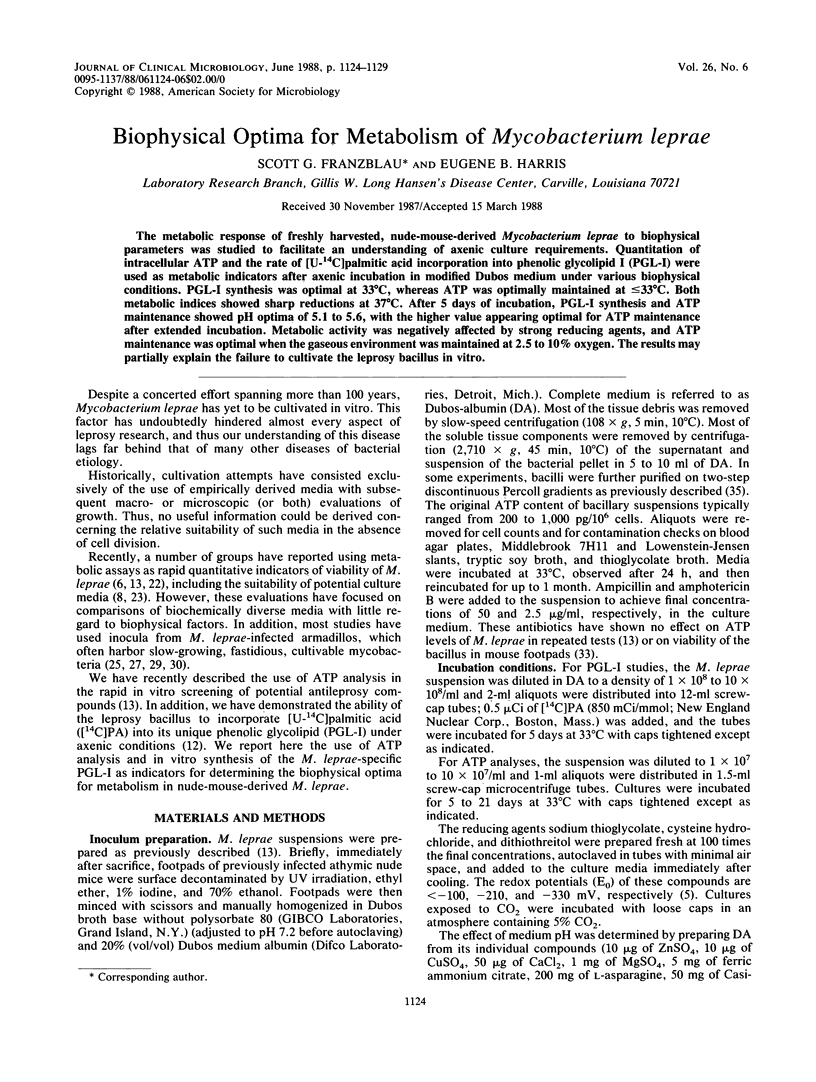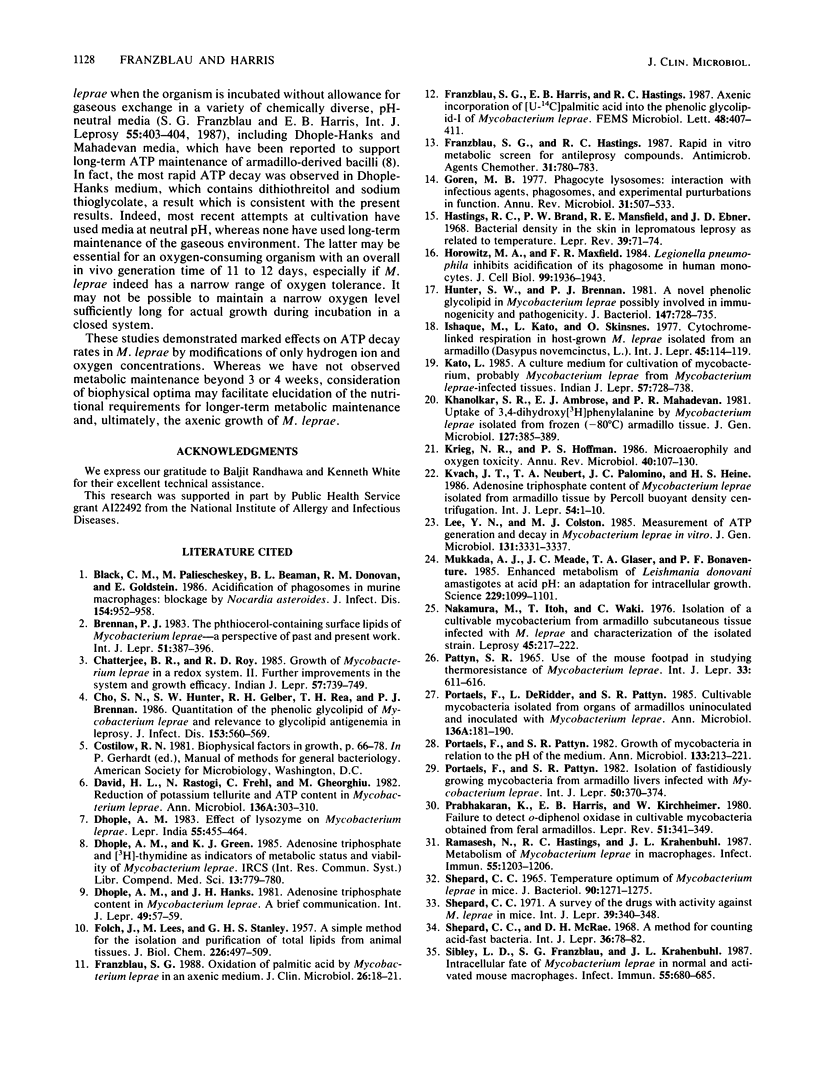Abstract
The metabolic response of freshly harvested, nude-mouse-derived Mycobacterium leprae to biophysical parameters was studied to facilitate an understanding of axenic culture requirements. Quantitation of intracellular ATP and the rate of [U-14C]palmitic acid incorporation into phenolic glycolipid I (PGL-I) were used as metabolic indicators after axenic incubation in modified Dubos medium under various biophysical conditions. PGL-I synthesis was optimal at 33 degrees C, whereas ATP was optimally maintained at less than or equal to 33 degrees C. Both metabolic indices showed sharp reductions at 37 degrees C. After 5 days of incubation, PGL-I synthesis and ATP maintenance showed pH optima of 5.1 to 5.6, with the higher value appearing optimal for ATP maintenance after extended incubation. Metabolic activity was negatively affected by strong reducing agents, and ATP maintenance was optimal when the gaseous environment was maintained at 2.5 to 10% oxygen. The results may partially explain the failure to cultivate the leprosy bacillus in vitro.
Full text
PDF





Selected References
These references are in PubMed. This may not be the complete list of references from this article.
- Black C. M., Paliescheskey M., Beaman B. L., Donovan R. M., Goldstein E. Acidification of phagosomes in murine macrophages: blockage by Nocardia asteroides. J Infect Dis. 1986 Dec;154(6):952–958. doi: 10.1093/infdis/154.6.952. [DOI] [PubMed] [Google Scholar]
- Brennan P. J. The phthiocerol-containing surface lipids of Mycobacterium leprae--a perspective of past and present work. Int J Lepr Other Mycobact Dis. 1983 Sep;51(3):387–396. [PubMed] [Google Scholar]
- Chatterjee B. R., Das Roy R. Growth of Mycobacterium leprae in a redox system: II. Further improvements in the system and growth efficiency. Indian J Lepr. 1985 Oct-Dec;57(4):739–749. [PubMed] [Google Scholar]
- Cho S. N., Hunter S. W., Gelber R. H., Rea T. H., Brennan P. J. Quantitation of the phenolic glycolipid of Mycobacterium leprae and relevance to glycolipid antigenemia in leprosy. J Infect Dis. 1986 Mar;153(3):560–569. doi: 10.1093/infdis/153.3.560. [DOI] [PubMed] [Google Scholar]
- Dhople A. M. Effect of lysozyme on Mycobacterium leprae. Lepr India. 1983 Jul;55(3):455–464. [PubMed] [Google Scholar]
- Dhople A. M., Hanks J. H. Adenosine triphosphate content in Mycobacterium leprae. A brief communication. Int J Lepr Other Mycobact Dis. 1981 Mar;49(1):57–59. [PubMed] [Google Scholar]
- FOLCH J., LEES M., SLOANE STANLEY G. H. A simple method for the isolation and purification of total lipides from animal tissues. J Biol Chem. 1957 May;226(1):497–509. [PubMed] [Google Scholar]
- Franzblau S. G., Hastings R. C. Rapid in vitro metabolic screen for antileprosy compounds. Antimicrob Agents Chemother. 1987 May;31(5):780–783. doi: 10.1128/aac.31.5.780. [DOI] [PMC free article] [PubMed] [Google Scholar]
- Franzblau S. G. Oxidation of palmitic acid by Mycobacterium leprae in an axenic medium. J Clin Microbiol. 1988 Jan;26(1):18–21. doi: 10.1128/jcm.26.1.18-21.1988. [DOI] [PMC free article] [PubMed] [Google Scholar]
- Goren M. B. Phagocyte lysosomes: interactions with infectious agents, phagosomes, and experimental perturbations in function. Annu Rev Microbiol. 1977;31:507–533. doi: 10.1146/annurev.mi.31.100177.002451. [DOI] [PubMed] [Google Scholar]
- Hastings R. C., Brand P. W., Mansfield R. E., Ebner J. D. Bacterial density in the skin in lepromatous leprosy as related to temperature. Lepr Rev. 1968 Apr;39(2):71–74. doi: 10.5935/0305-7518.19680013. [DOI] [PubMed] [Google Scholar]
- Horwitz M. A., Maxfield F. R. Legionella pneumophila inhibits acidification of its phagosome in human monocytes. J Cell Biol. 1984 Dec;99(6):1936–1943. doi: 10.1083/jcb.99.6.1936. [DOI] [PMC free article] [PubMed] [Google Scholar]
- Hunter S. W., Brennan P. J. A novel phenolic glycolipid from Mycobacterium leprae possibly involved in immunogenicity and pathogenicity. J Bacteriol. 1981 Sep;147(3):728–735. doi: 10.1128/jb.147.3.728-735.1981. [DOI] [PMC free article] [PubMed] [Google Scholar]
- Ishaque M., Kato L., Skinsnes O. K. Cytochrome-linked respiration in host grown M. leprae isolated from an Armadillo (Dasypus novemcinctus, L.). Int J Lepr Other Mycobact Dis. 1977 Apr-Jun;45(2):114–119. [PubMed] [Google Scholar]
- Kato L. A culture medium for cultivation of mycobacteria, probably Mycobacterium leprae from Mycobacterium leprae infected tissues. Indian J Lepr. 1985 Oct-Dec;57(4):728–738. [PubMed] [Google Scholar]
- Khanolkar S. R., Ambrose E. J., Mahadevan P. R. Uptake of 3,4-dihydroxy[3H]phenylalanine by Mycobacterium leprae isolated from frozen (-80 degrees C) armadillo tissue. J Gen Microbiol. 1981 Dec;127(2):385–389. doi: 10.1099/00221287-127-2-385. [DOI] [PubMed] [Google Scholar]
- Krieg N. R., Hoffman P. S. Microaerophily and oxygen toxicity. Annu Rev Microbiol. 1986;40:107–130. doi: 10.1146/annurev.mi.40.100186.000543. [DOI] [PubMed] [Google Scholar]
- Kvach J. T., Neubert T. A., Palomino J. C., Heine H. S. Adenosine triphosphate content of Mycobacterium leprae isolated from armadillo tissue by Percoll buoyant density centrifugation. Int J Lepr Other Mycobact Dis. 1986 Mar;54(1):1–10. [PubMed] [Google Scholar]
- Lee Y. N., Colston M. J. Measurement of ATP generation and decay in Mycobacterium leprae in vitro. J Gen Microbiol. 1985 Dec;131(12):3331–3337. doi: 10.1099/00221287-131-12-3331. [DOI] [PubMed] [Google Scholar]
- Mukkada A. J., Meade J. C., Glaser T. A., Bonventre P. F. Enhanced metabolism of Leishmania donovani amastigotes at acid pH: an adaptation for intracellular growth. Science. 1985 Sep 13;229(4718):1099–1101. doi: 10.1126/science.4035350. [DOI] [PubMed] [Google Scholar]
- Nakamura M., Itoh T., Waki C. [Isolation of a cultivable mycobacterium from an armadillo subcutaneous tissue infected with M. leprae and characterization of this isolated strain (author's transl)]. Repura. 1976 Oct-Dec;45(4):217–222. doi: 10.5025/hansen1930.45.4_217. [DOI] [PubMed] [Google Scholar]
- Pattyn S. R. Use of the mouse foot pad in studying thermoresistance of Mycobacterium leprae. Int J Lepr. 1965 Jul-Sep;33(3 Suppl):611–616. [PubMed] [Google Scholar]
- Portaels F., De Ridder K., Pattyn S. R. Cultivable mycobacteria isolated from organs of armadillos uninoculated and inoculated with Mycobacterium leprae. Ann Inst Pasteur Microbiol. 1985 Mar-Apr;136A(2):181–190. doi: 10.1016/s0769-2609(85)80057-0. [DOI] [PubMed] [Google Scholar]
- Portaels F., Pattyn S. R. Growth of mycobacteria in relation to the pH of the medium. Ann Microbiol (Paris) 1982 Sep-Oct;133(2):213–221. [PubMed] [Google Scholar]
- Portaels F., Pattyn S. R. Isolation of fastidiously growing mycobacteria from armadillo livers infected with Mycobacterium leprae. Int J Lepr Other Mycobact Dis. 1982 Sep;50(3):370–374. [PubMed] [Google Scholar]
- Prabhakaran K., Harris E. B., Kirchheimer W. F. Failure to detect o-diphenoloxidase in cultivable mycobacteria obtained from feral armadillos. Lepr Rev. 1980 Dec;51(4):341–349. doi: 10.5935/0305-7518.19800036. [DOI] [PubMed] [Google Scholar]
- Ramasesh N., Hastings R. C., Krahenbuhl J. L. Metabolism of Mycobacterium leprae in macrophages. Infect Immun. 1987 May;55(5):1203–1206. doi: 10.1128/iai.55.5.1203-1206.1987. [DOI] [PMC free article] [PubMed] [Google Scholar]
- Shepard C. C. A survey of the drugs with activity against M. leprae in mice. Int J Lepr Other Mycobact Dis. 1971 Apr-Jun;39(2):340–348. [PubMed] [Google Scholar]
- Shepard C. C., McRae D. H. A method for counting acid-fast bacteria. Int J Lepr Other Mycobact Dis. 1968 Jan-Mar;36(1):78–82. [PubMed] [Google Scholar]
- Shepard C. C. Temperature optimum of Mycobacterium leprae in mice. J Bacteriol. 1965 Nov;90(5):1271–1275. doi: 10.1128/jb.90.5.1271-1275.1965. [DOI] [PMC free article] [PubMed] [Google Scholar]
- Sibley L. D., Franzblau S. G., Krahenbuhl J. L. Intracellular fate of Mycobacterium leprae in normal and activated mouse macrophages. Infect Immun. 1987 Mar;55(3):680–685. doi: 10.1128/iai.55.3.680-685.1987. [DOI] [PMC free article] [PubMed] [Google Scholar]
- Sibley L. D., Weidner E., Krahenbuhl J. L. Phagosome acidification blocked by intracellular Toxoplasma gondii. 1985 May 30-Jun 5Nature. 315(6018):416–419. doi: 10.1038/315416a0. [DOI] [PubMed] [Google Scholar]
- Wheeler P. R., Gregory D. Superoxide dismutase, peroxidatic activity and catalase in Mycobacterium leprae purified from armadillo liver. J Gen Microbiol. 1980 Dec;121(2):457–464. doi: 10.1099/00221287-121-2-457. [DOI] [PubMed] [Google Scholar]
- Wheeler P. R. Metabolism in Mycobacterium leprae: its relation to other research on M. leprae and to aspects of metabolism in other mycobacteria and intracellular parasites. Int J Lepr Other Mycobact Dis. 1984 Jun;52(2):208–230. [PubMed] [Google Scholar]
- Wheeler P. R. Metabolism of carbon sources by Mycobacterium leprae: a preliminary report. Ann Microbiol (Paris) 1982 Jul-Aug;133(1):141–146. [PubMed] [Google Scholar]
- Wheeler P. R. Oxidation of carbon sources through the tricarboxylic acid cycle in Mycobacterium leprae grown in armadillo liver. J Gen Microbiol. 1984 Feb;130(2):381–389. doi: 10.1099/00221287-130-2-381. [DOI] [PubMed] [Google Scholar]


